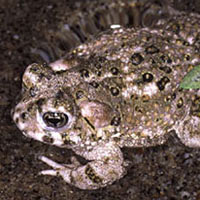Arroyo Toad No Longer Endangered?
Fish & Wildlife Service Suggests Species Shift to “Threatened”
In 1994, after dams and development booted the species from 75 percent of its original habitat, the arroyo toad was listed as federally endangered, with only 22 groups known to survive. This year, although there’s only one additional group to add to that list, the U.S. Fish & Wildlife Service is suggesting that the species be downlisted to “threatened,” a sign that the toad — which once thrived from the Salinas River to Baja California and still lives in a number of Los Padres National Forest watersheds — is on the slow path to recovery.
“They haven’t necessarily occupied a lot of newer areas, but the areas they do occupy, we consider them to be less threatened,” said the service’s Michael McCrary. “Not that everything is so great that we’re going to delist it. The downlisting is just an indication that progress has been made. That’s a good positive thing that encourages everyone to work toward eventually delisting, which is our ultimate goal.”

Specifically, the fears about destruction of natural waterways caused many worries in the 1980s and ’90s. “In the past, there was a lot more concern that we were going to be building dams or rip-rapping the streams,” said McCrary. “We haven’t really ended up doing a lot of the things we were concerned about.” As it stands, the only two rivers where the toad lives that are not dammed are the Sisquoc and Sespe, both located in the Los Padres, where the toad also lives in Piru, Indian, and Mono creeks.
Aside from being rare, the arroyo toad is also curious in other ways. “Unlike frogs and toads that live around ponds and marshes, these toads live along fast-flowing streams that are very typical of where we live in Southern California,” said McCrary, explaining that, during the winter when waters are high, they live far from the creeks — even going as far as 3,000 feet, or about 10 football fields, away — in sandy soils where they burrow and only hunt at night. Come spring and summer, when the creeks dry up, the toads come back down to breed and lay eggs in the remaining pools. That behavior does make them a preferred food item for bullfrogs, and also makes them susceptible to danger from human recreation, but both those threats are apparently not worrisome enough to warrant the species remaining endangered.
The service’s suggestion is now subject to public comments, and will trigger a year-long study of the toad to determine whether the downlisting should occur. To comment, see regulations.gov and enter FWS-R8-ES-2012-0026 as the keyword.


